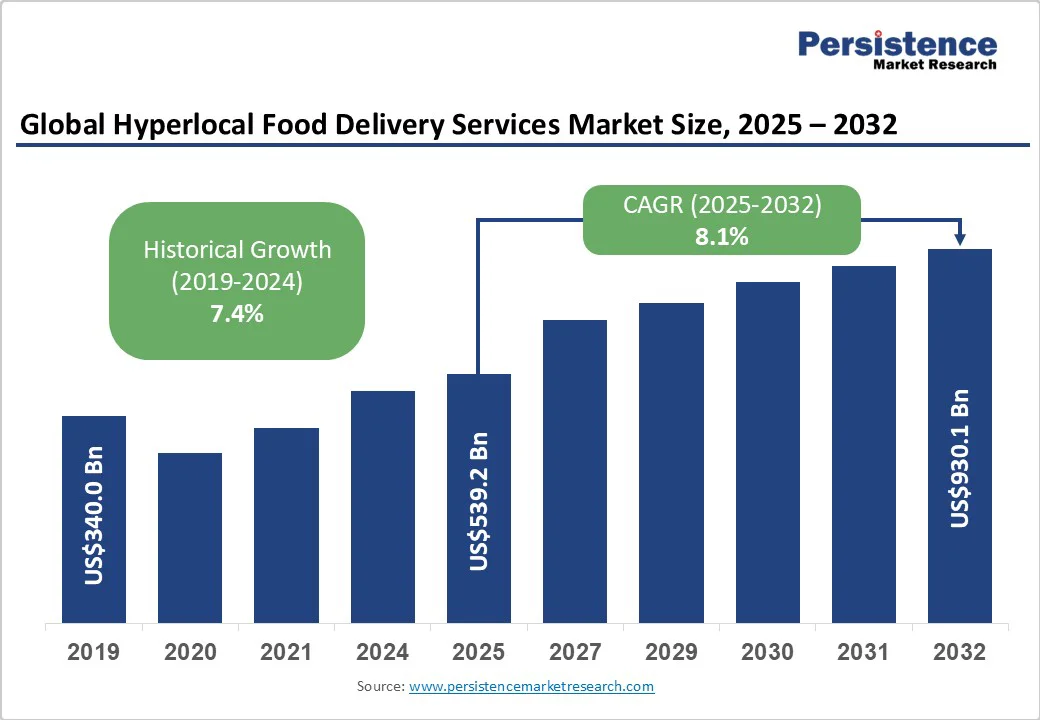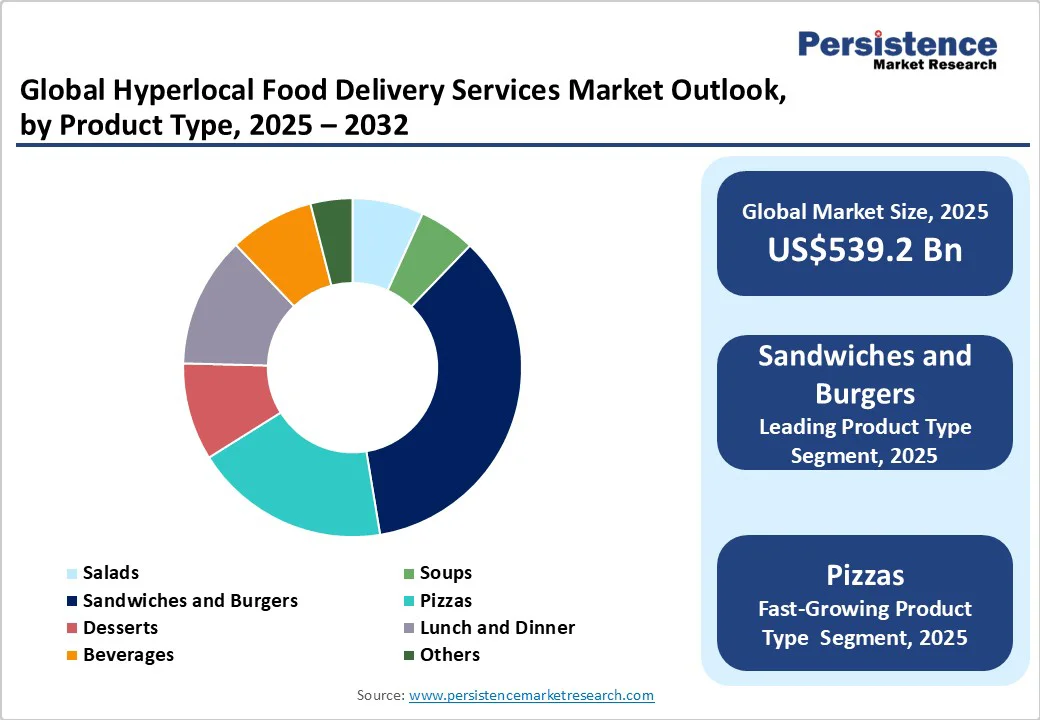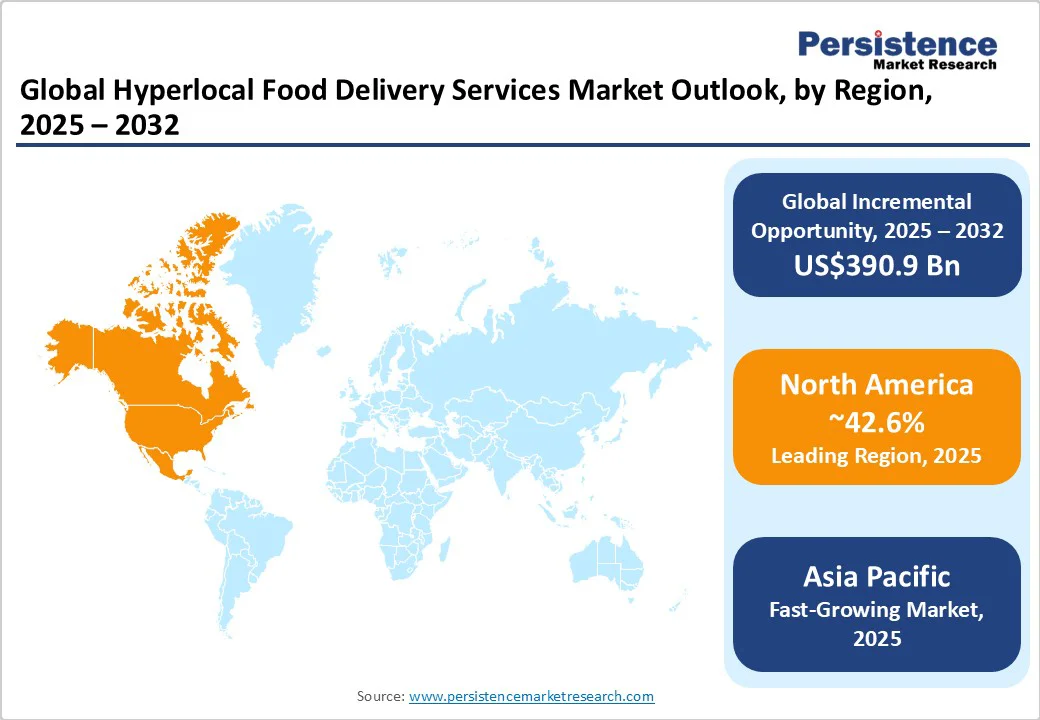ID: PMRREP35678| 182 Pages | 6 Oct 2025 | Format: PDF, Excel, PPT* | Food and Beverages

The global hyperlocal food delivery services market size is expected to be valued at US$539.2 billion in 2025. It is projected to reach US$930.1 billion by 2032, growing at a CAGR of 8.1% during the forecast period of 2025-2032, driven by increasing consumer demand for speed, convenience, and variety. Urban lifestyles have boosted the preference for instant meals and same-day grocery deliveries.
| Key Insights | Details |
|---|---|
|
Hyperlocal Food Delivery Services Market Size (2025E) |
US$539.2 Billion |
|
Market Value Forecast (2032F) |
US$930.1 Billion |
|
Projected Growth (CAGR 2025 to 2032) |
8.1% |
|
Historical Market Growth (CAGR 2019 to 2024) |
7.4% |

Consumers are now seeking quick, ready-to-eat meals that accommodate busy urban lifestyles. Hyperlocal food delivery services cater to this demand by offering a wide range of options, from restaurant-prepared dishes to groceries, all delivered within minutes. Platforms such as Uber Eats and DoorDash in North America, and Zepto and Swiggy in India, have adapted by introducing features, including one-click reordering, meal subscriptions, and predictive delivery times.
The COVID-19 pandemic accelerated this trend, normalizing home consumption and online ordering. Urban professionals and students mainly prefer platforms that combine speed with variety, as it saves time and reduces the requirement to cook.
Hyperlocal delivery platforms offer small restaurants, cafes, and grocery stores the opportunity to reach a much wider audience without incurring significant marketing or delivery infrastructure costs. For example, DoorDash’s Local Restaurants Program in the U.S. and Zomato’s Hyperpure initiative in India enable vendors to efficiently reach customers in their neighborhoods.
This model helps local businesses grow sales, maintain brand visibility, and compete with large chains, while the platform benefits from increased restaurant variety and order volume. In Europe, Deliveroo Editions has enabled local restaurants to test new menu concepts and expand into new neighborhoods by utilizing cloud kitchens, thereby reducing overheads.
Running a hyperlocal food delivery network requires significant investment in maintaining a dependable fleet of riders, bikes, or vehicles, along with specialized GPS tracking systems to monitor performance in real-time. Companies must also invest in training couriers, ensuring compliance with traffic safety rules, and handling insurance requirements, all of which add to the operational load.
Rising fuel costs and the push to integrate electric vehicles into delivery fleets further raise expenses. For instance, in Singapore and Tokyo, platforms are experimenting with electric two-wheelers to strike a balance between sustainability and efficiency; however, the upfront costs remain high. These expenses squeeze margins in a market already under pressure from competitive pricing.
One of the most prominent challenges for hyperlocal delivery platforms is maintaining the integrity of meals during transit. Hot items often lose their warmth, cold items such as ice cream risk melting, and liquids or delicate foods may spill, leading to customer complaints. This is particularly significant in dense cities like Mumbai or Jakarta, where traffic congestion can extend delivery times beyond the promised window, affecting both temperature and freshness.
Companies such as Zomato and Uber Eats have tested insulated bags and smart containers to counter these issues. However, they add extra costs and logistical complexity. Failure to deliver food in optimal conditions directly impacts brand trust and customer retention, making it a persistent barrier to growth despite technological fixes.
Ultra-fast delivery, often promised within 10 to 20 minutes, is transforming hyperlocal food services by meeting consumers’ high demand for convenience and speed. Platforms such as Zepto and Blinkit in India are setting benchmarks with deliveries under 15 minutes, while Flink in Germany and Gorillas across Europe are adopting similar strategies for groceries and ready-to-eat meals.
The models rely on micro-fulfillment centers or dense networks of dark stores to ensure proximity to consumers. This rapid service not only increases order frequency but also strengthens customer loyalty as users value the immediacy. Additionally, integrating AI-backed route optimization and predictive demand forecasting helps platforms maintain efficiency and reduce delivery costs.
Cloud kitchens, also known as delivery-only kitchens, are emerging as a strategic growth opportunity for hyperlocal food delivery platforms. By operating kitchens without dine-in facilities, companies can experiment with multiple virtual brands from a single location, optimizing menus and inventory management. Rebel Foods in India, for example, runs over 45 virtual brands through cloud kitchens, while Deliveroo Editions in the U.K. hosts multiple restaurants under one roof.
Cloud kitchens help reduce the dependence on traditional restaurant partners, lower rental and operational costs, and allow quick expansion in urban areas. Platforms can also customize menus for specific neighborhoods based on local preferences, ensuring high order success. This flexibility and cost efficiency make cloud kitchens a key factor in global expansion.
Sandwiches and burgers are expected to account for nearly 35.2% of the market share in 2025 as they are easy to prepare, transport, and consume on the go. Their compact size and packaging-friendly nature minimize spillage or spoilage, making them ideal for fast delivery services. Platforms such as Uber Eats and DoorDash highlight these items in ‘quick bites’ or combo deals, pushing frequent repeat orders.
Pizzas are poised to exhibit a considerable CAGR through 2032 owing to their versatility, shareable nature, and superior brand association with convenience meals. They are resilient to delivery delays because they retain taste and temperature better than various other foods. Domino’s, Pizza Hut, and local cloud-kitchen brands often use app-based customization and bundle offers to maintain customer loyalty.
Platform-to-consumer is anticipated to account for approximately 64.3% of the share in 2025, as it enables hyperlocal food services to directly manage the order experience, from placement to delivery, ensuring consistency, speed, and reliability. This model also allows platforms to collect valuable data on customer preferences and optimize route planning using AI, thereby improving efficiency and reducing delays.
The restaurant-to-consumer segment is expected to experience steady growth in the foreseeable future, as it enables eateries to maintain direct control over food preparation and presentation while reaching customers beyond their physical locations. Cloud kitchens and local restaurants utilize this model to expand sales without investing in their own logistics network.
Online payment is expected to hold a share of approximately 73.2% in 2025, as it offers speed, convenience, and seamless integration with apps. Digital wallets, UPI, and credit/debit card options allow customers to complete transactions instantly, supporting ultra-fast delivery models. Online payments also enable platforms to track transactions accurately, manage refunds efficiently, and run loyalty or subscription programs.
Despite the rise of online payments, cash-on-delivery (COD) remains a key option in hyperlocal food delivery, especially in regions with low digital penetration or among users who are wary of online transactions. COD allows hesitant customers to try new platforms without upfront risk, boosting trust and adoption. In India and parts of Southeast Asia, a significant portion of first-time users still prefer COD, helping platforms acquire and retain new customers.

In 2025, North America is expected to account for approximately 42.6% of the market share, as hyperlocal food delivery is shifting from just restaurant meals to a broader mix of groceries and essentials. DoorDash recently partnered with Kroger to cover all of its 2,700 stores, while Amazon added perishable food items such as milk and frozen dinners to its same-day service across 1,000 cities. This demonstrates how the major players are utilizing grocery expansion to retain users within their ecosystems.
Technology is becoming a competitive edge. DoorDash is testing Dot, a delivery robot in Phoenix that can travel on sidewalks and roads, while drone pilots are being run in Dallas-Fort Worth to deliver small grocery and meal orders. These experiments aim to reduce delivery costs and improve suburban coverage, where demand is increasing but human courier economics are weak. Legislation is further demanding better pay and labor protections for gig workers. New York City recently raised its minimum pay standards, causing platforms such as Uber and DoorDash to eliminate several driver slots in the city.
In the Asia Pacific, hyperlocal food delivery has become a central part of eating habits, with delivery now accounting for nearly a quarter of foodservice revenue. Consumers are moving toward affordable and bundled options, as inflation has made them more price-sensitive. Platforms are changing menus and offers, such as low minimum spends for solo diners in Singapore. In India, services such as MagicNow (part of Magicpin) now account for around 13% of its food-delivery orders, targeting 20% by FY26 through ultra-fast delivery.
BigBasket has launched a 10-minute food delivery service in Bengaluru, featuring brands such as Starbucks & Qmin. This shows the push into quick service even in non-mega urban centers. Innovation is also defining competition. Foodpanda in Singapore is using hyperlocal data to personalize offers at a neighborhood level. In China, companies such as Meituan are applying human-activity recognition technology across hundreds of thousands of riders to optimize routes and efficiency.
In Europe, hyperlocal food delivery is being transformed by consolidation and regulation. DoorDash’s US$3.9 Billion acquisition of Deliveroo has made it a key player across the region, while Delivery Hero and Glovo were fined over €329 Million (US$386.0 Million) by the EU for anti-competitive practices such as no-poach agreements. These moves show how competition and oversight are intensifying. Labor laws are a defining factor in the region.
Spain has compelled Glovo to hire thousands of riders as employees under its Riders Law, moving away from the gig model. At the EU level, the Platform Work Directive now presumes delivery riders are employees unless companies prove otherwise. In Germany, attempts by Lieferando to push contractors over employees have triggered strikes, highlighting the tension between platforms and workers. Dark stores and ghost kitchens are also facing resistance. Barcelona has banned new dark stores and moved dark kitchens to industrial zones.

The global hyperlocal food delivery services market is influenced by both global giants and regional specialists. Large platforms such as Uber Eats, DoorDash, and Zomato dominate by technology and brand recognition. Local start-ups, including Zepto, Blinkit, and Swiggy Instamart in India or Gorillas and Flink in Europe compete by providing ultrafast delivery through dark stores and micro-fulfillment centers. This dual structure means global players focus on breadth and partnerships, while hyperlocal ones win through speed and neighborhood-level relevance.
Market leaders in the field of hyperlocal food delivery focus on development through AI-based logistics, automation, and dark-store networks. Cost leadership is pursued via cloud kitchens, subscription models, and optimized delivery fleets. Expansion strategies include cross-border acquisitions and grocery integration. Emerging trends feature hybrid models blending food, retail, and quick commerce ecosystems for high retention.
The hyperlocal food delivery services market is projected to reach US$539.2 Billion in 2025.
Surging demand for instant meals and convenience-focused urban lifestyles are the key market drivers.
The hyperlocal food delivery services market is poised to witness a CAGR of 8.1% from 2025 to 2032.
Partnering with local vendors and expanding into suburban areas are the key market opportunities.
Grubhub, Deliveroo, and DoorDash are a few key market players.
|
Report Attribute |
Details |
|
Historical Data/Actuals |
2019 - 2024 |
|
Forecast Period |
2025 - 2032 |
|
Market Analysis |
Value: US$ Bn |
|
Geographical Coverage |
|
|
Segmental Coverage |
|
|
Competitive Analysis |
|
|
Report Highlights |
|
By Product Type
By Delivery Type
By Payment Type
By Region
Delivery Timelines
For more information on this report and its delivery timelines please get in touch with our sales team.
About Author